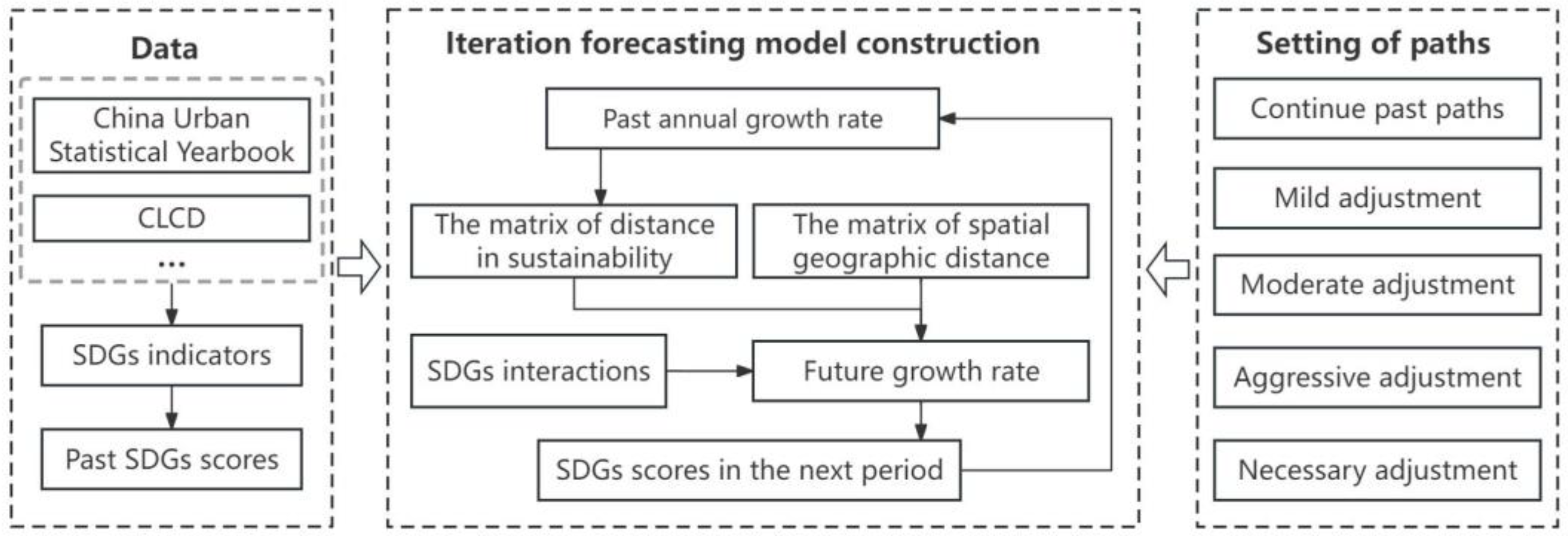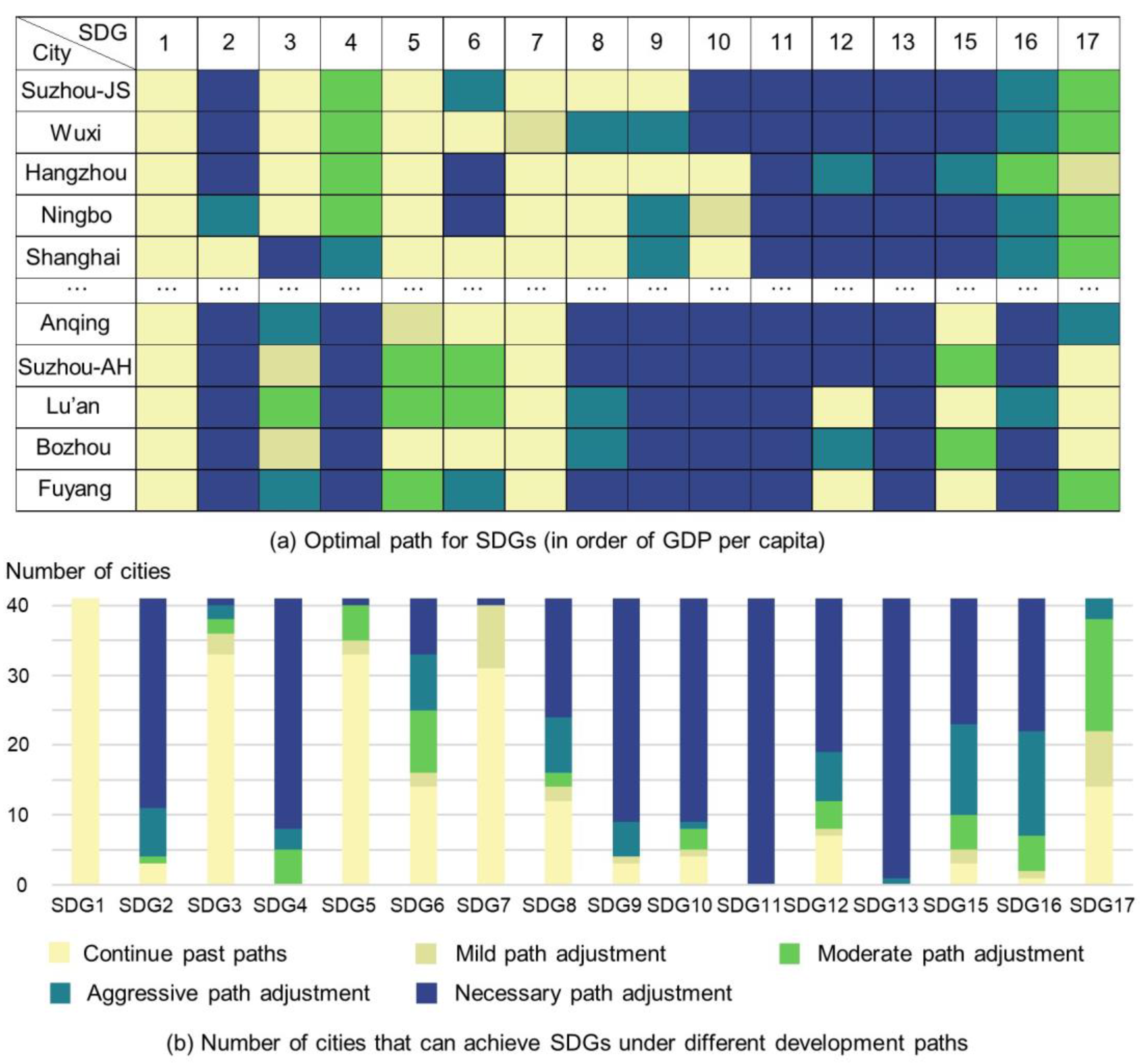Forecasting Future Development under the Interactions among Sustainable Development Goals
Abstract
:1. Introduction
2. Study Area and Data Acquisition
2.1. Study Area
2.2. Data Acquisition and Preprocessing
3. Methods
3.1. Interaction Analysis of SDGs
3.2. Construction of the Iterative Forecasting Model Considering SDG Interactions
3.3. Setting of the Development Paths
4. Results and Discussion
4.1. Simulation of the SDG Index up to 2030
4.2. Optimization of the Development Paths
5. Conclusions
Author Contributions
Funding
Institutional Review Board Statement
Informed Consent Statement
Data Availability Statement
Conflicts of Interest
References
- Allen, C.; Metternicht, G.; Wiedmann, T. Priorities for science to support national implementation of the sustainable development goals: A review of progress and gaps. Sustain. Dev. 2021, 29, 635–652. [Google Scholar] [CrossRef]
- Chen, J.; Peng, S.; Zhao, X.; Ge, Y.; Li, Z. Measuring regional progress towards SDGs by combining geospatial and statistical information. Acta Geod. Cartogr. Sin. 2019, 48, 473–479. [Google Scholar] [CrossRef]
- Guo, H.; Liang, D.; Chen, F.; Sun, Z.; Liu, J. Big Earth Data Facilitates Sustainable Development Goals. Bull. Chin. Acad. Sci. 2021, 36, 874–884. [Google Scholar] [CrossRef]
- Kostetckaia, M.; Hametner, M. How Sustainable Development Goals interlinkages influence European Union countries’ progress towards the 2030 Agenda. Sustain. Dev. 2022, 30, 916–926. [Google Scholar] [CrossRef]
- Allen, C.; Metternicht, G.; Wiedmann, T.; Pedercini, M. Greater gains for Australia by tackling all SDGs but the last steps will be the most challenging. Nat. Sustain. 2019, 2, 1041–1050. [Google Scholar] [CrossRef]
- Gu, C.; Guan, W.; Liu, H. Chinese urbanization 2050: SD modeling and process simulation. Sci. China Earth Sci. 2017, 60, 1067–1082. [Google Scholar] [CrossRef]
- Allen, C.; Metternicht, G.; Wiedmann, T. National pathways to the Sustainable Development Goals (SDGs): A comparative review of scenario modelling tools. Environ. Sci. Policy 2016, 66, 199–207. [Google Scholar] [CrossRef]
- Yang, Z. Sustainability of Urban Development with Population Decline in Different Policy Scenarios: A Case Study of Northeast China. Sustainability 2019, 11, 6442. [Google Scholar] [CrossRef]
- Pedercini, M.; Arquitt, S.; Chan, D. Integrated simulation for the 2030 agenda. Syst. Dyn. Rev. 2020, 36, 333–357. [Google Scholar] [CrossRef]
- Collste, D.; Pedercini, M.; Cornell, S.E. Policy coherence to achieve the SDGs: Using integrated simulation models to assess effective policies. Sustain. Sci. 2017, 12, 921–931. [Google Scholar] [CrossRef]
- Pedercini, M.; Zuellich, G.; Dianati, K.; Arquitt, S. Toward achieving Sustainable Development Goals in Ivory Coast: Simulating pathways to sustainable development. Sustain. Dev. 2018, 26, 588–595. [Google Scholar] [CrossRef]
- Qu, W.; Shi, W.; Zhang, J.; Liu, T. T21 China 2050: A Tool for National Sustainable Development Planning. Geogr. Sustain. 2020, 1, 33–46. [Google Scholar] [CrossRef]
- Xiao, H.; Xu, Z.; Ren, J.; Zhou, Y.; Lin, R.; Bao, S.; Zhang, L.; Lu, S.; Lee, C.K.M.; Liu, J. Navigating Chinese cities to achieve sustainable development goals by 2030. Innovation 2022, 3, 100288. [Google Scholar] [CrossRef] [PubMed]
- Spaiser, V.; Ranganathan, S.; Swain, R.B.; Sumpter, D.J.T. The sustainable development oxymoron: Quantifying and modelling the incompatibility of sustainable development goals. Int. J. Sustain. Dev. World Ecol. 2017, 24, 457–470. [Google Scholar] [CrossRef]
- Spangenberg, J.H. Hot Air or Comprehensive Progress? A Critical Assessment of the SDGs. Sustain. Dev. 2017, 25, 311–321. [Google Scholar] [CrossRef]
- Wiedmann, T.; Allen, C. City footprints and SDGs provide untapped potential for assessing city sustainability. Nat. Commun. 2021, 12, 3758. [Google Scholar] [CrossRef]
- Engström, R.E.; Collste, D.; Cornell, S.E.; Johnson, F.X.; Carlsen, H.; Jaramillo, F.; Finnveden, G.; Destouni, G.; Howells, M.; Weitz, N.; et al. Succeeding at home and abroad: Accounting for the international spillovers of cities’ SDG actions. npj Urban Sustain. 2021, 1, 18. [Google Scholar] [CrossRef]
- Lafortune, G.; Zoeteman, K.; Fuller, G.; Mulder, R.; Dagevos, J.; Schmidt-Traub, G. SDG Index and Dashboards Report for European Cities; SDSN: Paris, France, 2019. [Google Scholar]
- Yang, J.; Huang, X. The 30 m annual land cover datasets and its dynamics in China from 1990 to 2021. Earth Syst. Sci. Data 2022, 13, 3907–3925. [Google Scholar] [CrossRef]
- Fu, B.; Wang, S.; Zhang, J.; Hou, Z.; Li, J. Unravelling the complexity in achieving the 17 sustainable-development goals. Natl. Sci. Rev. 2019, 6, 386–388. [Google Scholar] [CrossRef]
- Zhang, J.; Wang, S.; Pradhan, P.; Zhao, W.; Fu, B. Untangling the interactions among the Sustainable Development Goals in China. Sci. Bull. 2022, 67, 977–984. [Google Scholar] [CrossRef]
- Lafortune, G.; Fuller, G.; Moreno, J.; Schmidt-Traub, G.; Kroll, C. SDG Index and Dashboards Detailed Methodological Paper; Sustainable Development Solutions Network: Paris, France, 2018. [Google Scholar]
- Cao, M.; Chen, M.; Zhang, J.; Pradhan, P.; Guo, H.; Fu, B.; Li, Y.; Bai, Y.; Chang, L.; Chen, Y.; et al. Spatio-temporal changes in the causal interactions among Sustainable Development Goals in China. Humanit. Soc. Sci. Commun. 2023, 10, 450. [Google Scholar] [CrossRef]
- Tobler, W.R. A Computer Movie Simulating Urban Growth in the Detroit Region. Econ. Geogr. 1970, 46, 234–240. [Google Scholar] [CrossRef]
- Warchold, A.; Pradhan, P.; Kropp, J.P. Variations in sustainable development goal interactions: Population, regional, and income disaggregation. Sustain. Dev. 2021, 29, 285–299. [Google Scholar] [CrossRef]
- Xiao, H.; Bao, S.; Ren, J.; Xu, Z. Transboundary impacts on SDG progress across Chinese cities: A spatial econometric analysis. Sustain. Cities Soc. 2023, 92, 104496. [Google Scholar] [CrossRef]
- Nodehi, M.; Arani, A.A.; Taghvaee, V.M. Sustainability spillover effects and partnership between East Asia & Pacific versus North America: Interactions of social, environment and economy. Lett. Spat. Resour. Sci. 2022, 15, 311–339. [Google Scholar] [CrossRef] [PubMed]
- Taghvaee, V.M.; Nodehi, M.; Arani, A.A.; Jafari, Y.; Shirazi, J.K. Sustainability spillover effects of social, environment and economy: Mapping global sustainable development in a systematic analysis. Asia-Pac. J. Reg. Sci. 2023, 7, 329–353. [Google Scholar] [CrossRef]
- Liu, Y.; Wang, Y.; Du, J.; Guo, H.; Wu, B.; Fu, B. Earth Big Data for Balanced Development Assessment. Bull. Chin. Acad. Sci. 2021, 36, 963–972. [Google Scholar] [CrossRef]
- Du, Y.; Sun, X.-X. Economic development and environmental quality—A case study of china prefecture-level cities. Environ. Prog. Sustain. Energy 2017, 36, 1290–1295. [Google Scholar] [CrossRef]
- Wang, X.; Fan, P.; Wu, Z.; Liang, Q. Pollution, demographic, and public willingness to participate in environment protection in China—A study based on micro-survey data. Environ. Sci. Pollut. Res. 2019, 26, 25117–25129. [Google Scholar] [CrossRef]
- Han, Z.; Jiao, S.; Zhang, X.; Xie, F.; Ran, J.; Jin, R.; Xu, S. Seeking sustainable development policies at the municipal level based on the triad of city, economy and environment: Evidence from Hunan province, China. J. Environ. Manag. 2021, 290, 112554. [Google Scholar] [CrossRef]
- Wu, W.; Zhang, T.; Xie, X.; Huang, Z. Regional low carbon development pathways for the Yangtze River Delta region in China. Energy Policy 2021, 151, 112172. [Google Scholar] [CrossRef]
- Wu, Q.; Cheng, J.; Chen, G.; Hammel, D.J.; Wu, X. Socio-spatial differentiation and residential segregation in the Chinese city based on the 2000 community-level census data: A case study of the inner city of Nanjing. Cities 2014, 39, 109–119. [Google Scholar] [CrossRef]





Disclaimer/Publisher’s Note: The statements, opinions and data contained in all publications are solely those of the individual author(s) and contributor(s) and not of MDPI and/or the editor(s). MDPI and/or the editor(s) disclaim responsibility for any injury to people or property resulting from any ideas, methods, instructions or products referred to in the content. |
© 2023 by the authors. Licensee MDPI, Basel, Switzerland. This article is an open access article distributed under the terms and conditions of the Creative Commons Attribution (CC BY) license (https://creativecommons.org/licenses/by/4.0/).
Share and Cite
Xu, Y.; Chen, Y.; Cao, M.; Chang, L.; Bai, Y.; Li, Y.; Guo, Y. Forecasting Future Development under the Interactions among Sustainable Development Goals. Sustainability 2023, 15, 15929. https://doi.org/10.3390/su152215929
Xu Y, Chen Y, Cao M, Chang L, Bai Y, Li Y, Guo Y. Forecasting Future Development under the Interactions among Sustainable Development Goals. Sustainability. 2023; 15(22):15929. https://doi.org/10.3390/su152215929
Chicago/Turabian StyleXu, Yuqing, Yu Chen, Min Cao, Lijiao Chang, Yuying Bai, Yue Li, and Yaqi Guo. 2023. "Forecasting Future Development under the Interactions among Sustainable Development Goals" Sustainability 15, no. 22: 15929. https://doi.org/10.3390/su152215929
APA StyleXu, Y., Chen, Y., Cao, M., Chang, L., Bai, Y., Li, Y., & Guo, Y. (2023). Forecasting Future Development under the Interactions among Sustainable Development Goals. Sustainability, 15(22), 15929. https://doi.org/10.3390/su152215929





